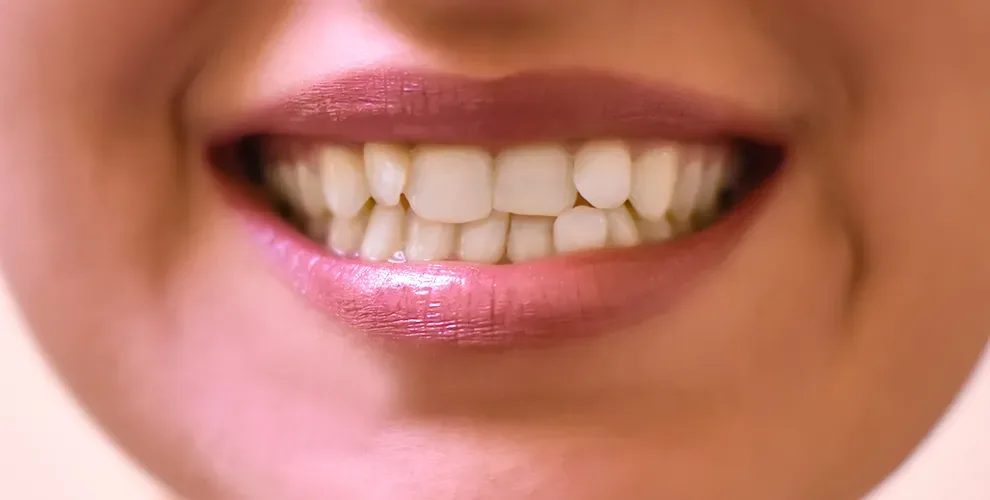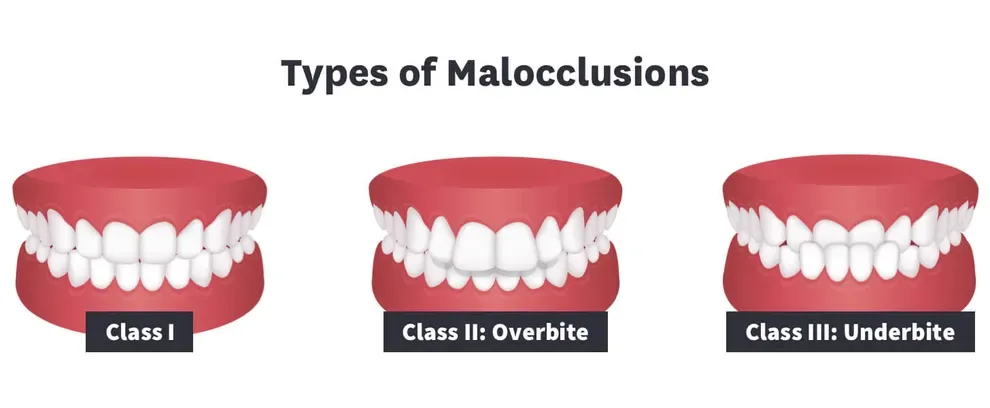The Most Common Types of Crooked Teeth

Table of Contents
- History
- Different Types
- Factors Influencing Crooked Teeth
- Cause Problems
- Treatment Options
- Crooked Teeth FAQs
- References
There are many different types of crooked teeth.
Bite issues, such as overbite or underbite, are categorized from mild to severe. Crossbites, open bites, and deep bites are additional types of bite problems.
Crowding, spacing, and protrusions also lead to crooked teeth.
A History of Misaligned or Crooked Teeth
Our jaws have evolved over time, becoming smaller as we eat more cooked foods and use utensils to divide food into bites. As our jaws have become smaller, our teeth have not changed much. This is why modern humans still have third molars, or wisdom teeth, for example.
Other problems are common due to our now smaller jaws, including misaligned teeth.
Genetics determine how much you will struggle with crooked or misaligned teeth throughout your life. Some people might never need braces or aligners, or they might not need them for long. Others may need to return to orthodontic treatment throughout their lives.
Different Types of Crooked Teeth

There are three basic types (classes) of malocclusion.
All three classes of malocclusion may feature the following:
Crowding: There is insufficient space in the jaw for all the teeth. This makes teeth harder to clean, increasing the risk of cavities and other oral hygiene issues.
Spacing: There is a lot of space between the teeth. Food can get stuck in open areas, which can lead to cavities and gum disease.
Tooth rotation: Some teeth are twisted or rotated.
Crossbite: This occurs when upper teeth fit inside lower teeth, so the lower jaw overlaps them. This can cause the jaw to shift to one side, making jaw pain more likely.
Open bite: Anterior open bites occur when the back teeth are together, but the front top and bottom teeth do not overlap. Posterior open bites occur when the front teeth meet but the back teeth do not. This can cause problems swallowing, tongue thrusting, and some speech problems, in extreme cases.
These are the three classes of crooked teeth (malocclusion):
This is the most common form of malocclusion and also the mildest. The bite (and usually, molar position) is normal, but the upper teeth slightly overlap the lower teeth.
The dental Dewey-Anderson classification system classifies Class 1 malocclusion into five categories:
Type 1: Overlapping teeth and crowding of front teeth
Type 2: Protruding incisor teeth with gaps or spacing
Type 3: Crossbite of front teeth
Type 4: Crossbite of back teeth
Type 5: Overcrowding of back teeth (lack of space)
Also called an overbite or retrognathism, this happens when the upper jaw and teeth severely overlap the lower jaw and teeth.
One type of overbite is overjet, also known as a protruding overbite or buck teeth. With an overjet, the front teeth appear to protrude outward.
An overbite can also cause a deep bite. When the bite is closed, the upper front teeth cover the lower front teeth too much. This can cause the upper teeth to bite into the lower gums, or the lower teeth to bite into the roof of the mouth.
Class 2 malocclusions are further categorized into two divisions:
Division 1: Upper teeth that slant forward
Division 2: Upper teeth that slant backward
Also referred to as an underbite or prognathism, this is a misalignment where the lower jaw sticks out or juts forward, so the lower teeth overlap the upper teeth and jaw.
Factors Influencing Crooked Teeth
While genetics largely determine the alignment of your teeth, some lifestyle factors can influence their alignment as well. These include the following:
Childhood habits, such as thumb sucking, tongue thrusting, and prolonged use of a pacifier or bottle
Having extra teeth like wisdom teeth for a long time, impacted teeth, abnormally shaped teeth, or losing teeth
Oral hygiene issues
Dental fillings, crowns, implants, appliances, braces, or retainers that do not fit
Misaligned fractures after an injury, surgery, or tumor
Teeth shifting after a lost tooth
Jaw conditions
Teeth grinding
When do Crooked Teeth Cause Problems with your Oral Health?
To understand the effect that malocclusion and crooked teeth can have on your oral health, the following factors need to be considered:
The build-up of harmful bacteria in the mouth (including plaque) can cause tooth decay and gum problems. These are two major causes of oral health issues. Malocclusion often involves crowding and spacing issues, which can both make teeth harder to clean and increase the risk of decay and gum irritation. With crowding, teeth are close together. The areas between them may be very narrow and hard to reach while cleaning. When there’s gaps between teeth, the space left in the gums can accumulate bacteria and (bacteria-feeding) food particles.
Crooked teeth and bite problems can create harmful bite patterns. For example, a top molar might brush against a bottom molar in an unnatural way, and this can cause wear and tear on the tooth, weakening the enamel and making it more prone to decay or damage. A bad bite pattern could also affect the gums. If a tooth is coming up against a part of the gums and causing friction, it could result in gum irritation and inflammation.
When crooked teeth are caused or related to a jaw issue, it can put strain on the jaw and surrounding muscles.
Ultimately, crooked teeth (malocclusion) can cause a variety of oral and general health problems if left untreated. These are some of the problems that may occur:
Tooth decay (including cavities)
Gum problems (inflammation or swollen gums)
Gum disease
Jaw disorders, including TMJ (temporomandibular joint disorders)
Jaw and muscle strain
Headaches
Neck pain
Problems speaking
Problems chewing and biting into food
Dry mouth
Self-consciousness, possibly affecting confidence and mental health
Treatment Options for Different Types of Crooked Teeth
Your treatment options will depend on what kind of crooked teeth you have, what’s causing the malocclusion, and how severe it is.
Cases of Class 1 malocclusion are the most minor. For these issues, there are two main treatment options:
Braces: Brackets are fixed onto teeth (cemented) and connected by a wire that is tightened regularly during adjustment appointments. The tightening applies pressure that forces the teeth to move over time. In addition to traditional metal braces, there are ceramic “invisible” braces and costly lingual braces, which are applied to the back of teeth.
Clear aligners: After getting an initial scan or impression of your current bite, a series of custom clear aligner trays are designed to fit over teeth and apply gentle pressure to progressively move them into place. Each tray is removable and clear. You’ll wear a set of trays for one or two weeks before switching to the next one.
If major crowding is present in a Class 1 malocclusion, a tooth removal (extraction) may also be needed to allow the teeth the room they need to shift into the correct bite position.
Cases of Class 2 and Class 3 malocclusion may also require braces, clear aligners, and/or tooth extraction to straighten teeth. While many types of Class 2 and Class 3 malocclusion can be corrected with clear aligners, some more severe or complex cases might call for traditional metal braces and longer treatment times.
In addition to these options, some Class 2 and 3 malocclusion cases may need additional correction options, including these:
Jaw (orthognathic) surgery: If the malocclusion is caused by jaw placement or structure (skeletal malocclusion), a correction or adjustment of the jaw may be needed.
Orthodontic devices: Common devices used in orthodontics include headgear (a removable appliance that usually includes bands attached to wiring inside and outside of the mouth) and a palatal expander (which is attached to the roof of the mouth and then expanded to widen the jaw).These appliances are most often used to influence jaw development in children and adolescents, whose jaws are not yet fully formed yet. They may also be used in adult orthodontics as well, though they don’t tend to be as effective as they are with children and teens.
Tooth replacement for missing teeth: If a missing tooth (or teeth) caused teeth to shift and create a bite problem, the missing teeth will need to be replaced with a bridge or dental implant to ensure the teeth won’t again shift after correction.
Crooked Teeth Frequently Asked Questions
Crooked teeth can have an impact on your appearance and self-esteem, but they can also impact your oral health. Crooked teeth may increase your risk of jaw problems, tooth decay, and gum disease. Because teeth shift with age, the misalignment may also get worse.
While it may seem okay to have crooked teeth, especially if they’re not severely misaligned, it may be advisable to correct the problem before it gets worse or creates complications.
There are three classes of malocclusions. All may feature alignment problems like tooth rotations, crowding, gaps, open bite (parts of the upper and bottom teeth don’t touch in places) and crossbite (in areas, the upper teeth can fit inside of the lower teeth).
Class 1 malocclusion refers to the mildest cases of misalignment. The bite is normal, but the upper front teeth minorly overlap the bottom teeth, and there are other alignment issues like crowding or gaps.
Class 2 malocclusion refers to cases of overbite, including buck teeth.
Class 3 malocclusion relates to cases of underbite, when the lower jaw juts out in front of the upper teeth.
Crooked teeth may seem like a minor problem, but your oral health (which is directly connected to your overall health) can be negatively affected by teeth misalignment and orthodontic issues. Those with crooked teeth may experience higher rates of tooth decay and damage, gum disease, and jaw disorders. Crooked teeth can affect daily activities like speech and eating, and it can also affect one’s appearance and self-esteem.
Which malocclusion cases will be considered severe may depend on the orthodontist and the type of malocclusion. The most severe cases may cause difficulty eating, speaking, and closing the mouth. Other severe cases may require jaw surgery and cause some abrasion between teeth or friction between teeth and gums.
